The vector field <0,0,z2> is not the curl of another vector field, because 0+0+2z is not always 0.
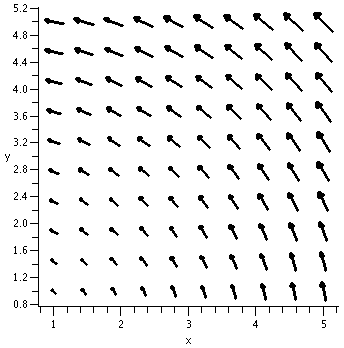
When is a vector field a gradient?
Several weeks ago we asked when a vector field could be a gradient
vector field. That is, given F=Pi+Qj+Rk,
when is there φ so that ∇φ=F? Although we can
integrate and compare the various descriptions, integration is
frequently tedious and difficult. I mentioned that a quick check can
be gotten by looking at the "cross second derivatives". The resulting
equations are also callled "compatibility conditions". Here is a
way of encoding this idea.
The curl
If F(x,y,z)=P(x,y,z)i+Q(x,y,z)j+R(x,y,z)k,
then the curl of F is another vector field, ∇xF. It is a cross-product, and can be
evaluated by taking the determinant:
( i j k )
det ( ∂/∂x ∂/∂y ∂/∂z )
( P(x,y,z) Q(x,y,z) R(x,y,z) )
It turns out this is equal to (if I don't foul up the signs!) the
following vector field:
If a vector field is a gradient, its curl is 0
A way of testing if a vector field is a gradient vector field: take
the curl: the result should be 0. Hamilton would want you to remember
this by writing ∇x∇f=0 since a vector crossed with
itself is 0.
The formula for curl is horrible, and difficult to remember but the
notation (especially the cross product and ∇) is supposed to
help. Suppose we ∂/∂x the i component of curl
F, ∂/∂y the
j component, and ∂/∂z the k component. Here in
this 21st century (!) math course, I may be doing this for
fun. The people who actually invented these results had the
computations forced on them (really!) because they wanted
descriptions of certain aspects of reality involving fluid flow and
electromagnetism. These are the three results we get for the
differentiations:
(Ryx–Qzx) –(Rxy–Pzy) (Qxz–Pyz).
A number of students observed that if we added these results, the
result would be 0! This is weird and wonderful (or weird and
remarkable, a phrase which might be used either positively or
negatively about many parts of this course).
If a vector field is a curl, its divergence is 0
Our conclusion is that a vector field G for which
∇·G is not 0 cannot be the curl of another
vector field. This is a "compatibility condition" for being a curl.
Example (from a textbook problem)
The vector field <0,0,z2> is not the curl of
another vector field, because 0+0+2z is not always 0.

What is the curl?
curl F is a complicated object. If F represents a fluid
flow, then each component of the curl of F is supposed to
represent the amount the fluid flow rotates around the corresponding
i or j or k. For example, a few
weeks ago we looked at the vortex flow, which was <–y,x,0>,
and has P=–y, Q=x. and R=0. Then
(Ry–Qz)i–(Rx–Pz)j+(Qx–Py)k
turns out to be (we computed it!) 0i+0j+2k: the
fluid "swirls" around the k axis at a uniform speed.
The darn curl is so complicated because analyzing the motion of a fluid is quite complicated and difficult, and the tools are correspondingly intricate.
The ingredients for Stokes' Theorem
Stokes' Theorem was developed in response to ideas of electromagnetism
and fluid dynamics. Just like Green, Stokes was interested in both
mathematics and physics, and he attempted to construct mathematical
models for rapidly evolving fields of physics. I will attempt to list
the ingredients for a (relatively!) straightforward version of Stokes'
Theorem.
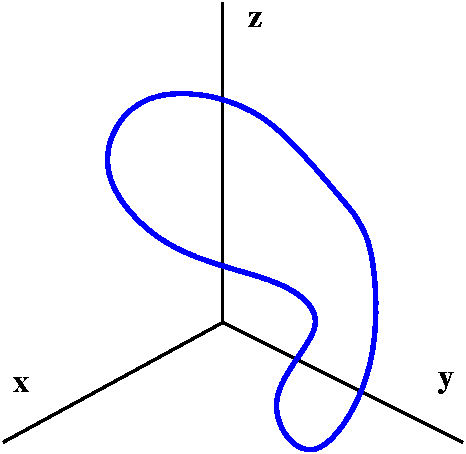
So this is a curve in space (R3) with START=END and which has no other self-intersections. |
 This should be a piece of a surface, all of whose boundary is the
curve mentioned above. As several students remarked, specifying the
boundary curve does not mean there's only one surface. In fact,
there are many really neat and clever computations which depend on
changing the surfaces involved. I'll show you one of these in a few
minutes.
This should be a piece of a surface, all of whose boundary is the
curve mentioned above. As several students remarked, specifying the
boundary curve does not mean there's only one surface. In fact,
there are many really neat and clever computations which depend on
changing the surfaces involved. I'll show you one of these in a few
minutes.
|
|
Stokes' Theorem connects the work of a vector field around a closed curve with the flux of a related vector field over a surface. So this means that we need to have a direction on the curve (how we push things around) and we also need to make a selection of normal vector on the surface. These choices need to be made together. The textbook interprets the work in the fluid dynamics sense, as a circulation. We didn't have enough time in class to consider circulation. There is discussion of this in sections 17.1 (on page 1010) and 17.2 (see page 1025). |
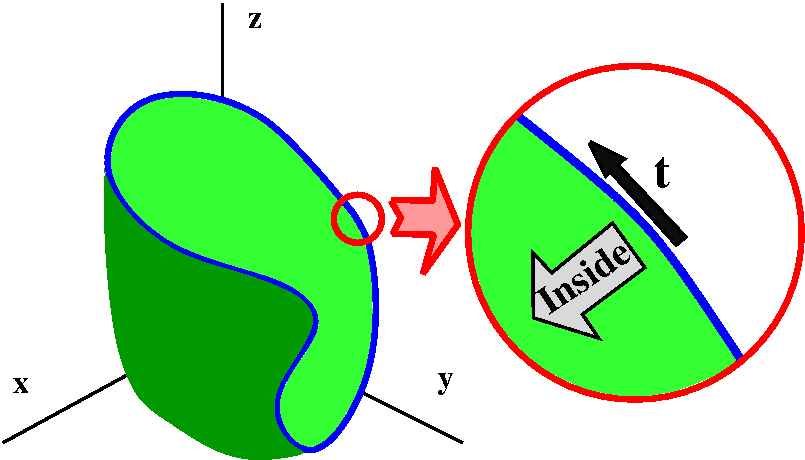 • How the surface and curve interact (by their orientations)
• How the surface and curve interact (by their orientations)
The word "orientation" here means how to select t, the unit
tangent vector on the boundary curve, and N, the unit normal on
the surface. The boundary curve will be a parameterized curve. It has
a unit tangent vector, t, pointing in the direction of
increasing parameter value. If we "walk" along the boundary curve in
this direction, the surface should be to our left. Now we have
t and a direction to the left. Complete this to a right-handed
coordinate system. The selection of N, the unit normal vector
to the surface, is made so N points in the direction of the
last entry of a right-handed coordinate system which begins with
t and the inside surface direction. I think in the accompanying
picture to the right, the N would point "out" of the page, and
towards the "inside" of the cup-shaped surface.
Under these conditions, then the Stokes Theorem Equation is true:
∫The boundary curveF·t ds=∫∫The surfacecurl F·N dS
The textbook writes this in a slightly different way as
∫The boundary curveF·ds=∫∫The surfacecurl F·dS
So the work or circulation of F around the boundary is equal to the flux through the surface of the curl F. This is a well-known complicated theorem. If the curve is in R2 and the surface is the inside of the curve, then the result is "just" Green's Theorem, which is already quite complicated. I'd like to spend most of the time in this lecture just checking both sides of the Stokes' Theorem equation, and getting some familiarity with it that way.
A textbook problem
 Here is a problem from a calculus textbook:
Here is a problem from a calculus textbook:
Verify that Stokes' Theorem is true for the vector field
F(x,y,z)=y2i+xj+z2k
and the surface is the part of the paraboloid
z=x2+y2 that lies below the plane z=1, oriented
upward.
Some discussion
The plane z=1 intersects the paraboloid in a circle. This is a circle
of radius 1 centered at (0,0,1). The paraboloid "overlays" a region
inside a circle of radius 1 centered at the origin in the xy-plane. We
will compute both integrals in Stokes' Theorem and (I hope!) get the
same answers. If the paraboloid is "oriented upward" then I presume
that the N points up. Going around the blue circle in the
standard (counterclockwise/positive) direction will orient the
boundary curve "compatibly": the t, the leftish piece of
surface next to the boundary curve, and the up N form a
right-handed triple. This took some time to see in class.
The work integral
So I need to compute ∫The curvey2dx+x dy+z2dz.
The curve is a circle, and can be parameterized as:
x=1cos(t) dx=–sin(t)dt y=1sin(t) dy=cos(t)dt z=1 dz=0and the parameterization interval for the whole circle is [0,2Π]. Then ∫The curvey2dx+x dy+z2dz becomes

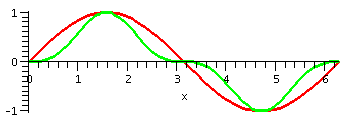


The surface integral
Now we need to compute
∫∫The paraboloidcurl F·N dS.
The curl
This is ∇xF, so:
( i j k ) det( ∂/∂x ∂/∂y ∂/∂z )=0i–0j+(1–2y)k ( y2 x z2 )Parameterizing the surface, etc.
( i j k ) det( 1 0 2u )=–2ui–2vk+1k ( 0 1 2v )We discussed the magical cancellation a few lectures ago. V·N dS became V·(ruxrv) dAu,v. curl F here is (1–2y)k=(1–2v)k so that curl F·N dS=(1–2v)k·(–2ui–2vk+1k)dAu,v=(1–2v)dAu,v.
Computation of the surface integral
We need to identify the domain in the uv-plane which parameterizes our
little cup. The uv-plane is the xy-plane in different clothing, but
the cup is the graph over the region inside the unit circle:
u2+v2≤1. So we need
∫∫Inside the unit circle(1–2v)dAu,v
But the 2v integrates to 0, since the region is symmetric in v and 2v is "odd" (the + and – cancels totally). The 1 in the integrand just gives the area, and the area inside the unit circle is Π(12), and this is Π.
This instantiation (?) of Stokes' Theorem is verified: Π=Π.
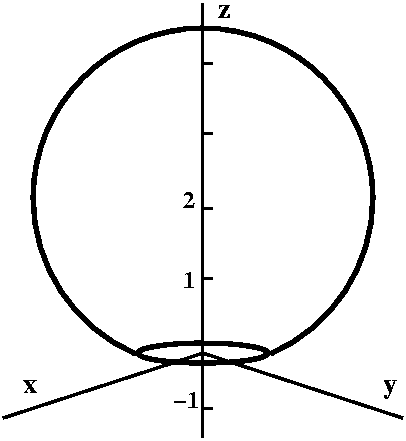 Another textbook problem
Another textbook problemHere is a slightly more vicious (viscous?) problem from the Stokes' Theorem section of a calculus text by Robert A. Adams: Find ∫∫The surfacecurl F·N dS where the surface is that part of the sphere x2+y2+(z–2)2=8 which lies above the xy-plane, and N is the outward unit normal on the surface, and F is y2cos(xz)i+x3eyzj–e–xyzk. Since the problem occurs in the Stokes' Theorem section of the text we should probably use Stokes' Theorem. The region of the sphere is shown to the right. The sphere is centered at (0,0,2) and its radius is sqrt(8)=2sqrt(2). So a portion of the sphere extends below the xy-plane.  The boundary of the top portion occurs if z=0 in the equation
x2+y2+(z–2)2=8. This becomes
x2+y2+(–2)2=8 so
x2+y2=4. This is a circle of radius 2 centered
at the origin in the xy-plane. We should establish the orientation of
this circle. If we look closely at a small piece of the surface near
the boundary curve, the outward unit normal points slightly down. We
must "walk" along the curve so that the surface is to the left. The
t direction is the standard counterclockwise direction on the
boundary circle. I hope the local picture to the right helps to
convince you of that. Again, the problem of deciding the resulting
orientation of one chunk (surface, boundary curve) from the other
(boundary curve, surface) has frequently seemed to me to be the most
complicated qualitative aspect of this problem.
The boundary of the top portion occurs if z=0 in the equation
x2+y2+(z–2)2=8. This becomes
x2+y2+(–2)2=8 so
x2+y2=4. This is a circle of radius 2 centered
at the origin in the xy-plane. We should establish the orientation of
this circle. If we look closely at a small piece of the surface near
the boundary curve, the outward unit normal points slightly down. We
must "walk" along the curve so that the surface is to the left. The
t direction is the standard counterclockwise direction on the
boundary circle. I hope the local picture to the right helps to
convince you of that. Again, the problem of deciding the resulting
orientation of one chunk (surface, boundary curve) from the other
(boundary curve, surface) has frequently seemed to me to be the most
complicated qualitative aspect of this problem.
Now Stokes' Theorem applies: ( i j k )
det ( ∂/∂x ∂/∂y ∂/∂z )=Blah!i–Blah, blah!j+[3x2eyz–2ycos(xz)]k
( y2cos(xz) x3eyz –e–xyz)
A further simplification occurs. We're on the xy-plane, where z=0. So
the k component, 3x2eyz–2ycos(xz), becomes
3x2–2y because cos(0)=1 and e0=1.
So we need ∫∫The disc3x2–2y dAu,v. Just as in the previous problem, the –2y integral over the disc is 0, because there is cancellation of the positive and negative contributions of y. I see no clever way to compute the 3x2 integral and will do this using polar coordinates (with x=rcos(θ)): ∫∫The disc3x2dAu,v=3∫θ=0θ=2Π∫r=0r=2r2[cos(θ)]2r dr dθ= 3∫θ=0θ=2Π[cos(θ)]2dθ∫r=0r=2r3dr. The θ integral is Π (a trick used before) and the r integral is 16/4. So the flux is 12Π.
Comment Also since the divergence of a curl is 0, the flux of a curl vector field on a closed surface must be 0 (the Divergence Theorem) so again the previous result is verified.
FTC through the ages ...
In the first half of the twentieth century, people began to understand
what's going on more systematically. All of these big
"Theorems" actually turn out to be special cases of a result that,
after the language is understood, is wonderful to contemplate. Here is an
appropriate Wikipedia link.
|